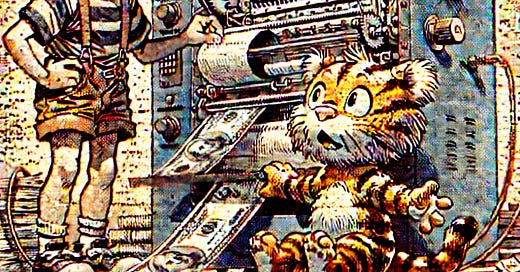What the Fed Is Actually Doing With These Rollovers
And why the semantics really don't matter...
Dear Fellow Traveler:
You know that feeling when someone tells you they're "not spending money" while also buying Uber Eats for the third time this week?
That's the Federal Reserve today...
Yesterday, I noted that the Fed had stepped in an made purchases of U.S. bonds. That’s been widely covered.
Critics (really semantics experts) argue that the Fed isn’t engaging in Quantitative Easing or any form of monetary easing…
They’re saying that the Fed is simply rolling over existing bond holdings, doing nothing new, and DEFINITELY NOT printing money.
That sounds reassuring… the same way your spouse says the credit card bill is "totally manageable" right before you see the number.
It's also complete nonsense.
The Fed Said It Would Shrink Its Balance Sheet (But Did It Really?)
Back in April, the Fed reduced the pace of its "Quantitative Tightening."
This is a fancy term for gradually unwinding the trillions of bonds it had purchased during the pandemic (and back to the Great Financial Crisis).
Think of it like promising to eat fewer cookies, but only cutting back from a dozen a day to eleven.
The Fed sets what they call a "cap."
It notes that no more than $5 billion in Treasuries would roll off the balance sheet per month.
This means they'd let only $5 billion expire without buying replacements.
Everything above that?
They'd reinvest it.
Which means… Wait for it… Hold…
Easy… Hold…
It means they’re buying more bonds.
It's like saying you're on a diet while still eating birthday cake, just smaller slices.
In June alone, the Fed bought tens of billions in Treasury bonds across 14 auctions.
These weren't backdoor, middle-of-the-night moves. They were public, scheduled purchases made through their System Open Market Account (SOMA).
The critics immediately jumped in…
"That's not easing… There’s no new paper. They’re just rolling over maturing debt. No new money here, folks!"
Sure…
And I'm just "hydrating" when I drink beer.
Yes — It Is New Money (Despite What They Tell You)
These critics either fail to understand or conveniently overlook one thing…
When a Treasury bond matures, the Treasury repays the Fed.
That cash technically disappears from circulation… unless the Fed replaces it.
And guess what?
That's exactly what they're doing.
For everything over the $5 billion cap, the Fed funds those new bond purchases by creating new bank reserves.
These aren't recycled dollars collecting dust in some vault.
They're brand-new Fed liabilities that enter the system as fresh liquidity, credited directly to the banks that sold the bonds.
That's money creation.
That's reserve injection.
And while it might not be Quantitative Easing… it aims to achieve the outcomes linked to QE - more liquidity, less volatility, and financial stability...
Trying to change the semantics to things like “Passive Support” is like calling a hot dog a "meat cylinder."
That’s technically accurate, but you're not fooling anyone.
"But the Balance Sheet Isn't Growing!" (Missing the Point Entirely)
Another hallmark of people defending the Fed and playing armchair FOMC spokesperson is the argument that the Fed’s balance sheet hasn’t expanded.
And if the balance sheet hasn’t expanded… that’s not QE.
I’m aware that the balance sheet didn’t increase… but it's mostly flat, just like my enthusiasm for listening to more semantic arguments about monetary policy.
But there’s a huge problem for this go-to “gotcha” argument that is supposed to end the conversation.
QE isn't just about the size of the balance sheet.
It's about the effect on reserves.
It’s about the actual money flowing through the banking system.
By reinvesting tens of billions, the Fed is keeping those reserves from falling.
That supports liquidity.
It holds down borrowing costs.
It eases pressure on the global financial system.
I don’t care if you call it QE… QE-lite… or Steve.
The outcome is the same.
We get more liquidity than there would be without it.
And the markets react accordingly…
What Michael Howell Argued
Capital Wars author Michael Howell always says that people fixate on "QE vs QT" semantics.
And that’s the problem.
The real issue is liquidity (or capital) in the financial system.
Whether these latest actions by the Fed are called "Quantitative Support" or "Activist Issuance," the Fed is responding to a system-wide liquidity need.
The entire global financial system depends on these rollovers to keep refinancing debt.
Without them, we risk a liquidity crunch and market instability.
The Fed knows this.
The banks know this.
Anyone who reads the Capital Wave Report knows this…
Hell, even my neighbor's golden retriever probably knows this, now just hearing me talk about it through the walls.
The Bottom Line (Someone Has to Say It)
The Fed may have slowed its tightening, but it absolutely didn't stop supporting the market.
They're quietly injecting fresh reserves through these rollover operations while everyone argues about what to call it.
It's like arguing whether the house is flooding or just "experiencing elevated moisture levels" while you're standing ankle-deep in water.
Function matters more than labels.
A system is always defined by its outcomes.
This system is defined by bailouts, liquidity injections, and ongoing support from central banks to ensure stability.
What the Fed is doing right now… in June 2025… is supportive.
Not neutral. Not tight.
Not "just rolling over existing positions."
Supportive.
The Fed can dress it up however they want.
However, they’re injecting liquidity at auctions to prevent what would otherwise be a collapse in bank reserves.
The system depends on these operations to keep the debt refinancing machine running smoothly.
Without them?
We're facing a potential liquidity crunch similar to the one we saw during the GILT Crisis or the Silicon Valley Bank crisis.
The problem is that in this higher-interest-rate environment, a lack of support would make everyone's problems significantly more expensive, very quickly.
Stay positive,
Garrett Baldwin







This is breaking news.
I guess the analysts don't read the auction results.
Or aren't supposed to talk about it...
But the Fed bought another $4.3b of the $43b of 7-year notes sold today bringing their monthly total to around $45b...
I guess that's not newsworthy.
And definitely not QE...